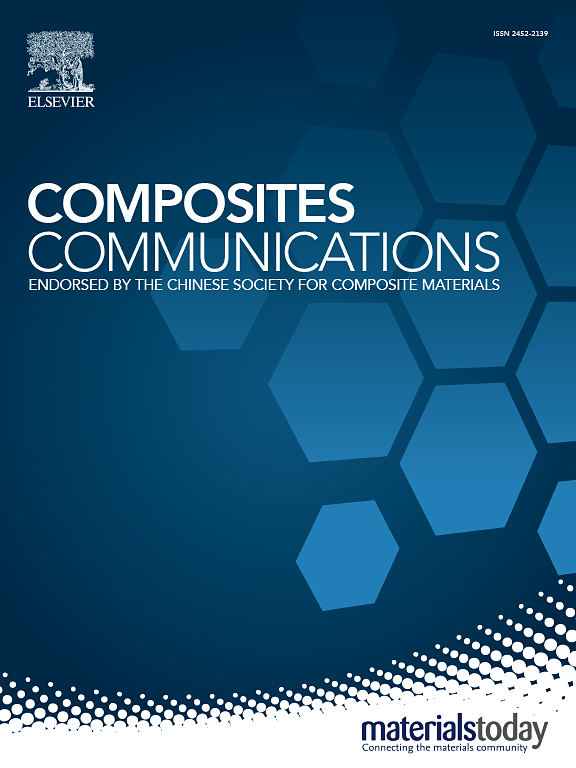Curved surface coupled structural battery composites manufactured by resin transfer molding process: Microstructure and multifunctional performance
IF 7.7
2区 材料科学
Q1 MATERIALS SCIENCE, COMPOSITES
引用次数: 0
Abstract
To bridge industrial production and lab-scale research, this work demonstrates a technology to manufacture curved surface structural battery composites (CSBCs) that can simultaneously achieve electrochemical energy storage and load-bearing. The curved-surface carbon fiber structural anode and cathode are fabricated by coating the active materials on carbon fiber fabric with a vacuum-bag-assisted technique. The resin transfer molding (RTM) process is conducted to manufacture the coupled CSBCs by infusing bi-continuous phase epoxy resin electrolyte and curing at high temperatures. The microstructure of structural electrodes and CSBCs is characterized by scanning electron microscopy (SEM). Due to good interfacial compatibility between high mechanical strength carbon fiber structural electrode and high ionic conductivity solid polymer electrolyte bulk for load support, the fabricated CSBCs demonstrate a high density of 294 mWh kg−1 based on the whole mass of devices, a tensile strength of 257.4 MPa with Young's modulus of 12.9 GPa and a flexural strength of 194.1 MPa with flexural modulus of 11.1 GPa. In situ electrochemical-mechanical tests further confirm the durability of CSBCs under mechanical loads with a multifunctional efficiency of 1.07, suggesting the effectiveness of the introduced manufacturing techniques for coupled structural battery composites.
采用树脂传递模塑工艺制造的曲面耦合结构电池复合材料:微观结构与多功能性能
为了在工业生产和实验室研究之间架起一座桥梁,这项工作展示了一种制造曲面结构电池复合材料(CSBC)的技术,这种复合材料可同时实现电化学储能和承重。通过真空袋辅助技术在碳纤维织物上涂覆活性材料,制造出曲面碳纤维结构正负极。通过注入双连续相环氧树脂电解液并在高温下固化,采用树脂传递模塑(RTM)工艺制造耦合 CSBC。扫描电子显微镜(SEM)对结构电极和 CSBC 的微观结构进行了表征。由于高机械强度碳纤维结构电极与高离子传导性固体聚合物电解质之间具有良好的界面相容性,因此所制备的 CSBC 具有较高的密度(基于器件的整体质量,密度为 294 mWh kg-1)、拉伸强度为 257.4 MPa(杨氏模量为 12.9 GPa)和弯曲强度为 194.1 MPa(弯曲模量为 11.1 GPa)。原位电化学-机械测试进一步证实了 CSBC 在机械负载下的耐用性,其多功能效率为 1.07,表明所引入的制造技术在耦合结构电池复合材料方面的有效性。
本文章由计算机程序翻译,如有差异,请以英文原文为准。
求助全文
约1分钟内获得全文
求助全文
来源期刊

Composites Communications
Materials Science-Ceramics and Composites
CiteScore
12.10
自引率
10.00%
发文量
340
审稿时长
36 days
期刊介绍:
Composites Communications (Compos. Commun.) is a peer-reviewed journal publishing short communications and letters on the latest advances in composites science and technology. With a rapid review and publication process, its goal is to disseminate new knowledge promptly within the composites community. The journal welcomes manuscripts presenting creative concepts and new findings in design, state-of-the-art approaches in processing, synthesis, characterization, and mechanics modeling. In addition to traditional fiber-/particulate-reinforced engineering composites, it encourages submissions on composites with exceptional physical, mechanical, and fracture properties, as well as those with unique functions and significant application potential. This includes biomimetic and bio-inspired composites for biomedical applications, functional nano-composites for thermal management and energy applications, and composites designed for extreme service environments.
 求助内容:
求助内容: 应助结果提醒方式:
应助结果提醒方式:


